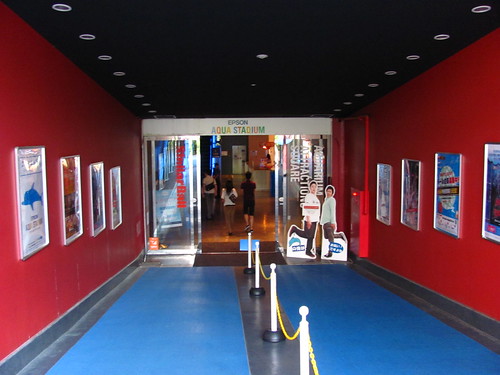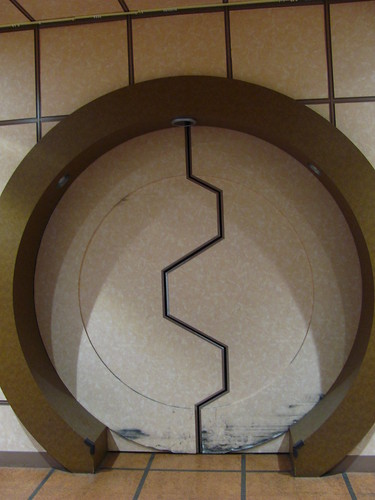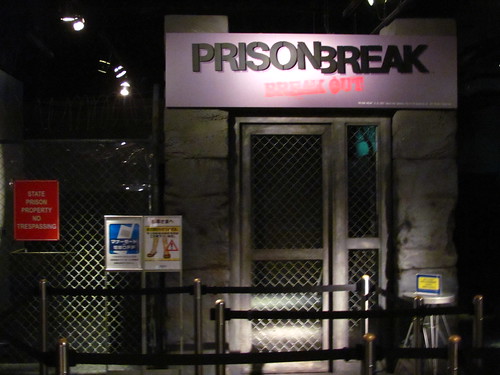Tokyo, Japan – Wednesday, June 22nd, 2011
After five months in Asia, I had reached my ultimate destination. Sort of.
Tokyo was the last place I would check into a new accommodation. This was the moment when I knew I was closing in on the end, but with a very busy week ahead of me in Tokyo, the end still didn’t feel too close. Especially on my first day in the world’s largest city, where I planned a jam-packed schedule to try to accomplish in one day, my mind was on other things, like the fact that my camera’s SD card was getting mighty full.
To keep things light I didn’t bring my laptop with me for this trip, having shipped the rest of my supplies back home from Hong Kong save for a backpack of the necessaries. Overall this was a good idea for my spine’s health, but with thousands of photos accumulating on that card with no way to back them up, I was constantly paranoid over anything happening to that camera. The memories were still too fresh from what happened last year, and that was when I still backed up my photos daily. The consequences were quite existential; if all that documentation were to disappear, especially as a solo traveler sharing my experiences with no one other than myself, it wouldn’t be long before memories fade and written testimonies grow unreliable, and it would almost be as if none of this had ever happened at all. I was putting in too much effort for this to only exist within my own mind. (As you can tell by the fact that there have been photos with all of these reports, it all turned out fine. But given that it took nearly a decade to get around to documenting this trip, I sure as hell wouldn’t be able to remember even a quarter of the details without those photos.)
With no time to waste, I set off from my hostel in the Asakusabashi district, taking a short ride to the nearby historic Asakusa neighborhood.
This area is famed for its ancient Senso-ji temple, which was completed in 645 and is now the oldest temple in Tokyo, although it was re-built following World War II. It includes some massive paper lanterns.
Flanking either side of this gate are two giant straw sandals, or owaraji, which are said to keep demons away.
Asakusa is also known for its extensive collection of restaurants and food stalls. Having just had a free toast and boiled egg breakfast at my hostel, I wouldn’t need to get anything to eat now, but I would be back to Asakusa later in my trip.
Another reason to return: Hanayashiki Amusement Park, the oldest operating amusement park in Japan, is located just steps away from the Senso-ji temple. Not today, however.
Instead I had a much more modern urban amusement park to check out: Tokyo Dome City, with its Intamin megacoaster Thunder Dolphin perched on the side of a skyscraper and threading a hubless Ferris wheel.
While Tokyo Dome City may appear very modern, it also felt like it was becoming close to defunct. Thunder Dolphin closed for unspecified mechanical reasons a few months before my visit, and would remain non-operational all the way through to summer of 2013. Given that many of the other significant rides in LaQua at Tokyo Dome City had been removed altogether in recent years (not least of which was the prototype Intamin Impulse coaster, Linear Gale, which had already closed and been removed the previous fall) it’s a wonder that the amusement rides including Thunder Dolphin are still around. They even added an indoor Gerstlauer coaster called “Panic Coaster – Back Daaan” in 2019.
But back in June 2011, it turned out there was little reason to visit. With the only remaining coaster closed for the foreseeable future, and seemingly all the other significant rides either removed completely or also in a state of dereliction, that left only one thing to ride: The Big O hubless Ferris wheel, also by Intamin. At ¥800 (or about $10.00USD at 2011 exchange rates), it was not exactly a cheap ride.
For that money, I would have appreciated slightly cleaner, clearer glass to look out through.
I’m honestly surprised that more hubless Ferris wheels haven’t been sold. The aesthetics seem like they’d be popular with urban developers with money to burn, although I’m guessing they can’t be made nearly as large as the mega-observation wheels which have become a much more attractive way to burn that sweet, sweet developer dough.
The Wonder Drop, a log flume with no one on it, was one of the few attractions that appeared operational.
A parachute ride and drop tower ride both were under refurbishment.
Elsewhere, a Water Symphony performed for an audience of one.
I didn’t stick around Tokyo Dome City for long. If I ever find myself in Tokyo again, it’s an easy destination to stop by and, maybe, ride an Intamin megacoaster with an awkward trick track on top of a building.
From Tokyo Dome City, it was a short ride south to the Chiyoda district and the Imperial Palace.
The East Gardens are open to visitors, which was the main area I strolled through. Apparently during the Japanese property bubble in the 1980’s the land the palace occupied in the center of Tokyo was valued at a higher price than all the real estate in California combined.
Seeing the Imperial Palace itself requires a reservation for a guided tour. I wasn’t able to make that fit my schedule, so I had to be content with viewing the palace from the outside for a few minutes, including the famous Nijubashi bridge. Overall I wouldn’t recommend visiting the Imperial Palace without a tour reservation, as there wasn’t enough to see from the outside to make the stop really worth the time investment.
My next stop was a ways south to the Shinagawa Prince Hotel where the Aqua Stadium is located. It required a bit of a walk from Shinagawa Station but some large signs made sure I didn’t get lost.
While Aqua Stadium is primarily known for its large aquarium, there was a small separate indoor amusement section that I was here for. As of 2011, the the amusement section featured a total of three rides, starting with the Dolphin Party carousel.
Port of Pirates was an elaborately themed swinging ship that was unfortunately closed for my visit, or I might have been tempted to give it a try.
The big attraction was Galaxy Express 999, an indoor Intamin coaster that frankly defies most conventional coaster categorizations, but I’ll get to that a bit later.
The attraction diverges from the ocean theme of the rest of Aqua Stadium in favor of a popular sci-fi anime property. It didn’t have much resonance with me beyond the fact that it’s a flying space train, but nevertheless I was fairly impressed by the attention to detail for what’s essentially a three-ride FEC.
It even includes an animatronic pre-show. Lots of talking in Japanese, and with the same repeated body movements and flat robotic intonation, I came away with just about zero idea what the story was supposed to be about.
But now onto to the coaster. The 15-car train utilizes low-slung straddling seating with lapbars similar to that found on the Atlantis Adventure Intamin Aquatrax coaster.
Situated in the front row, the ride launches forward on a set of tire drives. Instead of a typical straight launch, it bends around a banked curve. Launched coaster or powered coaster? The highlight is a vertical loop in the dark, which I was absolutely not expecting on a coaster with such minimalist seating. The drive tires even continue up the circumference of the loop, so I didn’t approach it at a speed nearly fast enough for a full inversion like that, yet nevertheless it managed to push us up and around and over, with gravity taking over from there. So not really a full powered coaster, either? From that point on it awkwardly wobbles around a long, flat helix with some star field and cosmic effects, before the tires slow us back down for a return to the unload station.
While it looks quite similar to the load station, it’s actually a different platform. My memories are a little fuzzy and I don’t have great documentation (nor was I able to find any corroborating info from a quick online search), but I have a vague recollection that I noticed there appeared to be a gap in the track at the tunnel at the end of the unload platform, indicating that there was either a transfer to return to the station, or even that the ride might launch in reverse back to the loading platform. (Why else use so many drive tires?) I’m very possibly wrong in that memory, and either way I’d never have the chance to further investigate, as barely 40 seconds after the ride began we were already being escorted down the exit ramp; one coaster count richer and ¥1,000 poorer.
Sadly, Galaxy Express 999’s weirdness ended in 2014, less than 10 years after it was built. The carousel and pirate ride still remain as the indoor park’s only two attractions, so I’m not sure why they would need to remove their signature attraction or what, if anything, it was replaced with.
I was now off to my last and longest activity of the day, taking the Rainbow Bridge across Tokyo Bay to the popular Odaiba area.
When in Tokyo…
Of course, I was really here for some more family-friendly amusements at Tokyo Joypolis, an indoor interactive FEC by SEGA, created somewhat in the style of DisneyQuest although arguably more successful as evidenced by the fact that it’s still around. (The presence of an actual roller coaster along with virtual attractions that are modular enough to be periodically updated might have something to do with it.)
Despite being an arcade-style set-up, Joypolis offers pay-one-price as it primary ticketing options, with spectator passes also available. While an all-day attraction pass can be a little pricey, they also offer steeply discounted evening tickets for the last few hours the park is open, which is about all the time one would need anyway, making it easy to fit near the end of a busy schedule while in Tokyo.
With ticket purchased, the portal slides open, and there a multistory cornucopia of arcade games and digitally-enhanced attractions was presented before me.
Luckily the coaster was located literally steps away from the main entrance, making it easy to get the Serious Business out of the way first. Spin Bullet was my first stop.
Spin Bullet was a bizarre spinning coaster built in a fairly low-clearance corner of Joypolis, meaning no big drops but lots of random, low-speed dips and switchbacks, including multiple short lifts. One of only a few rides built by its manufacturer in the 90’s, Spin Bullet loads its two-passenger cars from the front, with a truly horrific overhead restraint design involving cushioned straps that come down over your arms so you can only bend them at the elbow. I’ve never seen an arm restraint on a coaster quite like this. I guess the reach envelop was an issue with this ride?
That said, the randomness of this unique coaster made it kinda dumb fun, and much longer than it should have been for the space it occupies. I even ended up riding it a second time later in the evening. I must have been among the last riders of Spin Bullet, as it permanently closed sometime in 2011 to be replaced a year later by an Gerstlauer launched looping spinning interactive coaster. (Whew, that’s a lot of attributes for what looks to be a much shorter ride.)
Nearby the Halfpipe Canyon was Joypolis’ other big “can’t miss” attraction on the ground floor.
Find (or get assigned with) a partner and strap into the stand-up restraints atop a surfboard for an interactive pendulum ride with 90 degree swings. There’s an interactive element where you step on a tilt panel on the bottom of the board in time with the swings to get it to rotate, although after trying to get the rhythm precise for the first half of the ride, I soon discovered there seemed to be little difference compared to just randomly mashing it.
Continuing upward, there were a couple of interactive simulator racing games to try. One had you racing inside a fully built car atop a motion platform, which would have made for a cool experience if the actual game screens positioned in front of the car had a wider field of view than an in-home entertainment system.
Storm G had an interesting gimmick: a racing sim that was capable of actual 360 degree barrel rolls. Again, while the concept was unique and it was fun whenever you were able to trigger a barrel roll, the fact that it only capable of lateral rotation meant that the motion simulator aspect was mostly ineffective.
Sky Cruising appeared to be a hang-gliding simulator that I didn’t try.
Let’s Go Jungle was an interactive on-rails shooter game in which you play as a superbly milquetoast young white couple with relationship issues on a jungle vacation gone wrong as they’re pursued by giant spiders that you shoot with machine guns. The set-up and characterization could have made for a fun story, unfortunately it was largely abandoned right away as large quantities of giant spiders tend to flatten out any other nuances. The game quickly became hopeless, possibly because I was trying to fend them off all by myself in a game designed for multiple players. I lasted barely 30 seconds, frustrated that I was effectively given no possible chance to save their relationship from being immediately devoured by arachnids.
A trio of non-interactive “push-in” motion simulator attractions named Wild River, Wild Jungle, and Wild Wing offered a good density of entertainment value in a very small space. I don’t recall any of the simulator films being particularly good (most of the favorite tropes of the genre were represented), but sometimes quantity with just barely enough quality is enough.
Two other attractions I tried: the redundantly named Prison Break: Break Out, which I believe was an escape room of sorts, and an atmospheric audio-based J-Horror experience called The Room of the Living Dolls. Both had challenges for non-Japanese speakers, though even still had enough moments of interest to transcend the language barriers.
Various other arcade games, temporary booths, and SEGA property tie-ins fill up the remaining spaces around Joypolis. The result felt a little slapdash.
A Virtual Reality zone with VR tech from 2011 sounds like a particularly unappealing experience. Even a decade later I’d be happy to avoid it.
A celebrity signing wall spotted on the way out, featuring an unexpected collection of names.
 Overall Joypolis was an decent value way to spend a couple hours in the evening, with the pay-one-price model encouraging me to stay and sample a number of experiences I might not have normally sought out after I had completed the coaster. The novelty value alone was worth something. That said, as of 2011 there were definitely room for upgrades, as many areas looked and felt less like a sleek technological utopia playscape and more like a tired mall arcade with some upscaled games. I’d probably go back next time I’m in Tokyo, partly for the new coaster, partly to see how well the game technology (and overall environmental design) has advanced since a decade ago, and partly because there’s a lot more of interest in the Odaiba area, such as the award-winning teamLab: Borderless digital art attraction.
Overall Joypolis was an decent value way to spend a couple hours in the evening, with the pay-one-price model encouraging me to stay and sample a number of experiences I might not have normally sought out after I had completed the coaster. The novelty value alone was worth something. That said, as of 2011 there were definitely room for upgrades, as many areas looked and felt less like a sleek technological utopia playscape and more like a tired mall arcade with some upscaled games. I’d probably go back next time I’m in Tokyo, partly for the new coaster, partly to see how well the game technology (and overall environmental design) has advanced since a decade ago, and partly because there’s a lot more of interest in the Odaiba area, such as the award-winning teamLab: Borderless digital art attraction.
Either way, I’d have time to explore more areas around Tokyo later in the week. My next immediate goals were once again focused on coasters, first and most specifically to take care of some unfinished business.































































































































Never got on Spin Bullet, but came around 2 years later and got on Veil of Dark. REALLY fun little spinner! I was sad 999 closed. I wish I had ridden it twice (although I didn’t think it was THAT good). It was unique enough though. Tracking down both these rides was a memorable evening in Tokyo, 2013.
Yeah, I love finding unique one-off attractions scattered around a city like this. Seems like it’s tough for them to survive as property values continue to go up.